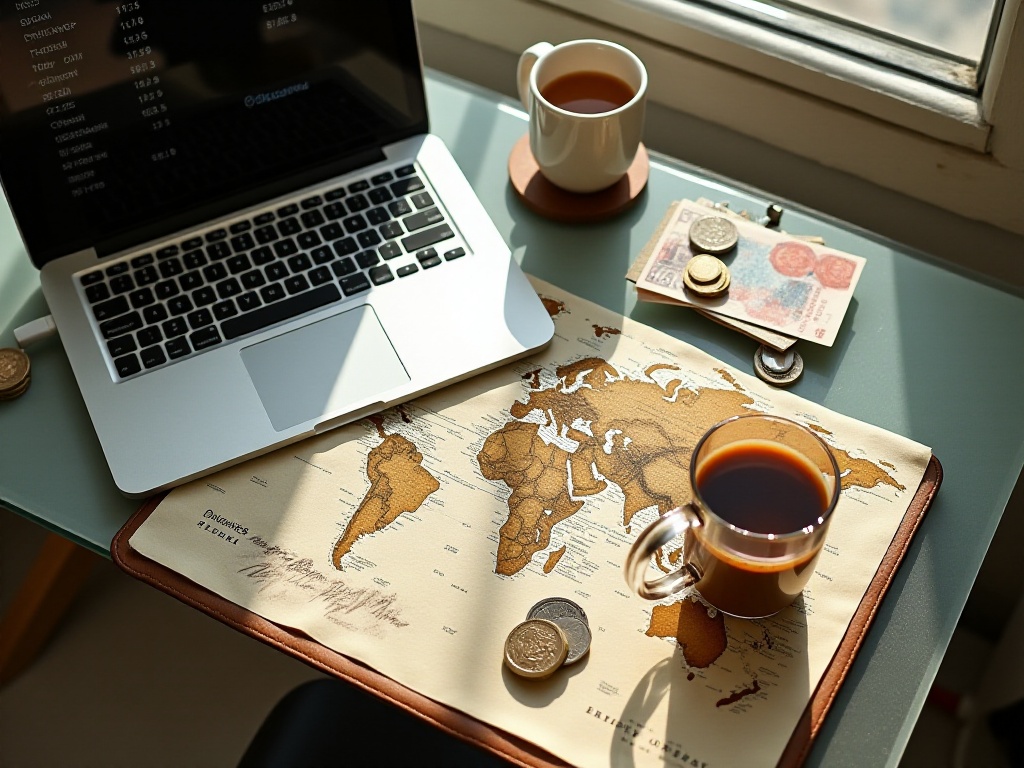Introduction
Every time I scroll through social media, I see stunning travel photos, but in the comments section, I often spot complaints like "spending too much" or "wallet's empty." As a seasoned backpacker who has visited over 30 countries, I deeply relate: travel doesn't necessarily require big spending - the key is proper planning. I remember when I first started traveling around the world, I was a complete budgeting novice, often maxing out my credit cards on impulse purchases. But after years of exploration and practice, I've finally mastered a complete travel budget planning method, which I'll share with you today.
Why Plan?
To be honest, when I first started traveling abroad, I had no concept of budget planning. Back then, I thought I could just bring my credit card, buy whatever I wanted, and pay it off slowly later. Looking back, that thinking was incredibly naive.
I remember once in Japan, I was so tempted by the figure shops in Akihabara! But since I had no idea how much budget I had left, I had to suppress my shopping urge. Later, when I saw limited edition cosmetics in Ginza, adorable plushies in Shinjuku, and limited edition sneakers in Shibuya... each time I would look and look, but didn't dare to make a purchase. Back at the hotel, I couldn't sleep, thinking "I should have planned ahead what to buy."
Even worse, when I got back home and received my credit card bill, the number took my breath away. Apart from flights and accommodation, I spent nearly 5,000 yuan just on convenience store snacks and transportation! This doesn't even include the skincare products I "casually" bought at drugstores and the anime merchandise I picked up "by the way."
According to Ctrip's latest "2023 Travel Consumption Report," impulsive consumers like me aren't rare. The data shows that over 65% of travelers exceed their budgets, with an average overspending of 38%. In other words, if you originally budgeted 10,000 yuan for your trip, you might end up spending 13,800. Just looking at that number hurts!
Therefore, whether it's to avoid indecision during the trip or prevent regrets afterward, proper budget planning is absolutely necessary. It's like buying "travel insurance" for yourself, making the entire journey more relaxed and enjoyable.

Where to Start
Through my many travel experiences, I've developed a super practical "SMART" principle. This method isn't something I imagined - it's been summarized through countless practices and adjustments.
Let's start with "Specific." This step seems simple but actually contains hidden complexities. For instance, "I want to go to Japan" is too vague. You need to refine your goal to something like "I want to see lavender in Hokkaido next May for 7 days." Why be so specific? Because costs can vary greatly depending on the season and region. Take Hokkaido for example - May is the beginning of lavender season with fewer tourists, so accommodation prices are much lower than during the peak season of July and August.
Next is "Measurable." This step requires thorough research to quantify every expenditure. Based on my firsthand experience staying in various parts of Japan, daily expenses in Tokyo range from 1,500-2,000 yuan, and that's being relatively frugal. If you want better hotels or have strong shopping desires, that number needs to go up. Hokkaido, with its relatively lower cost of living, requires about 1,200-1,600 yuan per day. As for the Kansai region, places like Kyoto and Osaka, 1,300-1,800 yuan per day is a reasonable range.
Then there's "Achievable." This point is especially important because even the most perfect budget plan is just theoretical if it exceeds your financial capability. From my experience, setting aside 10%-15% of your monthly salary for a travel fund is a good choice. For example, if your monthly salary is 8,000 yuan, saving 800-1,200 for travel won't affect your daily life while gradually making your travel dreams come true.
"Realistic" is also crucial. I've seen too many people be overly idealistic when planning their budgets, only to find various unexpected changes once they arrive. Therefore, I suggest reserving 15%-20% of the total budget for emergencies. This money can handle exchange rate fluctuations (who could predict the yen would suddenly appreciate?) or deal with unexpected situations (like needing to buy a new suitcase if yours breaks).
Finally, there's "Time-bound." Setting a clear savings timeline is important. Personally, I like to set small goals: save enough for airfare within three months, prepare 70% of the total budget within six months. Such timelines don't put too much pressure on myself while ensuring enough time to raise funds.

How to Spend
Now that we've covered the overall framework, let's talk about specific expense categories. This part might be detailed, but it's all based on real experience.
First is transportation costs. Many people might think transportation is just about buying a plane ticket, but there's actually much more to it. Taking Japan as an example, transportation alone has several levels: international flights, domestic travel, and local transportation.
International flight prices fluctuate greatly - the same round-trip to Tokyo might cost 4,000-5,000 yuan during peak season but just over 2,000 during off-peak. The JR Pass is a popular choice, with a 7-day pass costing about 1,500 yuan - definitely the most economical choice if you plan to visit multiple cities. As for local transportation, in Tokyo for example, a one-day subway pass costs 500 yen (about 25 yuan) - seems small but adds up over several days.
Accommodation is the second largest expense. There are many options here, from luxury hotels to capsule hotels. In Tokyo, one night's stay can range from 200 yuan to thousands or even tens of thousands. I personally recommend business hotels, priced at 800-1,200 yuan per night, offering good value for money. If you're really on a tight budget, youth hostels are a good option at 200-300 yuan per night. Just remember that Japanese accommodations are generally smaller than what you might expect in China.
Food expenses are the most easily underestimated part. In Japan, a regular bowl of ramen costs 40-50 yuan, a decent sushi set at least 200-300 yuan, and if you want to experience a Michelin restaurant, the budget needs to be several times higher. My suggestion is to split your food budget into two parts: 60% for daily meals like convenience store rice balls and fast food sets, and the remaining 40% for special local cuisines you want to try. This way you can taste local delicacies without overspending.
Attractions and shopping expenses are the hardest to control because you'll always encounter "unexpected surprises." Tokyo Disneyland tickets cost about 400 yuan, but spending inside the park is another story. Akihabara figures range from tens to thousands of yuan, with limited editions potentially costing even more. So I suggest making a must-buy list first, checking approximate prices, then reserving some budget for impulse purchases.

Money-Saving Tips
After talking about all these expenses, let's share some money-saving tips. These are practical experiences I've accumulated over the years, and they definitely work.
Planning ahead cannot be emphasized enough. Take flights for example - I've observed price trends for many routes, and booking 3-4 months ahead is usually most economical, saving 30%-40% compared to near-departure prices. The same applies to accommodation, especially during peak season. Last year, I booked a Kyoto guesthouse six months in advance for 1,000 yuan per night, while the same room's real-time price during peak season reached 2,200 yuan!
Choosing suitable travel times can also save a lot. Many people want to visit Japan during cherry blossom season, but prices then are crazy. According to Japan National Tourism Organization data, hotel price differences between peak and off-peak seasons can reach 40%-60%. So if your schedule is flexible, avoid Golden Week (late April to early May) and cherry blossom season (late March to early April). Japan is also beautiful in early summer and late autumn, with much lower prices.
Making good use of various discounts is also a skill. Now all major OTA platforms have their own membership systems with points redemption, coupons, and cashback promotions. Don't waste credit card miles either - save enough and you can redeem flights. Last year, I used credit card points to redeem an economy ticket to Tokyo, saving nearly 3,000 yuan. Also, following airline official accounts is important as they often release special ticket offers.
Another lesser-known money-saving tip is properly utilizing tax-free policies. In Japan, many items are tax-free, but different stores have different tax-free thresholds and refund rates. Generally, large shopping malls and chain stores have more convenient tax-free procedures. Some malls also offer additional discounts for tourists with specific bank cards, so it's best to do research before departure.

Final Words
After saying all this, the most important thing is finding a budget planning method that suits you. The purpose of budget planning isn't to restrict your spending but to make your travel more relaxed and enjoyable. Through reasonable planning, you can definitely have memorable travel experiences within your budget.
Everyone has different travel styles, so naturally, budget planning methods will differ. Some people like to calculate carefully, others enjoy spontaneous spending - there's no right or wrong. The key is finding a balance point where you're neither too constrained during travel nor affecting your normal life after returning due to excessive spending.
By the way, do you have your own unique travel budget planning insights? Or have you encountered any unexpected expenses during travel? Feel free to share your stories in the comments. In the next article, I'll introduce some practical travel accounting apps in detail to make budget planning simpler and more efficient - remember to follow!


